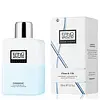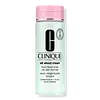What's inside
What's inside
 Key Ingredients
Key Ingredients

No key ingredients
 Benefits
Benefits

 Concerns
Concerns

 Ingredients Side-by-side
Ingredients Side-by-side

Water
Skin ConditioningHydrogenated Polyisobutene
EmollientSimmondsia Chinensis Seed Oil
EmollientDisodium Laureth Sulfosuccinate
CleansingSodium C14-16 Olefin Sulfonate
CleansingCocamidopropyl Betaine
CleansingGlycerin
HumectantSodium Lauryl Sulfoacetate
CleansingOlea Europaea Fruit Oil
MaskingTocopheryl Acetate
AntioxidantSpirulina Maxima Extract
SmoothingCucumis Sativus Fruit Extract
EmollientCamellia Oleifera Leaf Extract
AstringentSea Water
HumectantButylene Glycol
HumectantDisodium EDTA
Sodium Chloride
MaskingSodium Sulfate
Chlorphenesin
AntimicrobialCaprylyl Glycol
EmollientHexylene Glycol
EmulsifyingPhenoxyethanol
PreservativeParfum
MaskingCI 42090
Cosmetic ColorantWater, Hydrogenated Polyisobutene, Simmondsia Chinensis Seed Oil, Disodium Laureth Sulfosuccinate, Sodium C14-16 Olefin Sulfonate, Cocamidopropyl Betaine, Glycerin, Sodium Lauryl Sulfoacetate, Olea Europaea Fruit Oil, Tocopheryl Acetate, Spirulina Maxima Extract, Cucumis Sativus Fruit Extract, Camellia Oleifera Leaf Extract, Sea Water, Butylene Glycol, Disodium EDTA, Sodium Chloride, Sodium Sulfate, Chlorphenesin, Caprylyl Glycol, Hexylene Glycol, Phenoxyethanol, Parfum, CI 42090
Water
Skin ConditioningLauramidopropyl Betaine
CleansingCocamidopropyl Hydroxysultaine
CleansingSodium Chloride
MaskingSodium Laureth Sulfate
CleansingSodium Cocoyl Sarcosinate
CleansingTea-Cocoyl Glutamate
CleansingButylene Glycol
HumectantAloe Barbadensis Leaf Juice
Skin ConditioningPEG-120 Methyl Glucose Dioleate
EmulsifyingSucrose
HumectantSodium Coco Pg-Dimonium Chloride Phosphate
CleansingCitric Acid
BufferingHexylene Glycol
EmulsifyingPolyquaternium-7
Caprylyl Glycol
EmollientDisodium EDTA
Methylchloroisothiazolinone
PreservativeMethylisothiazolinone
PreservativePhenoxyethanol
PreservativeWater, Lauramidopropyl Betaine, Cocamidopropyl Hydroxysultaine, Sodium Chloride, Sodium Laureth Sulfate, Sodium Cocoyl Sarcosinate, Tea-Cocoyl Glutamate, Butylene Glycol, Aloe Barbadensis Leaf Juice, PEG-120 Methyl Glucose Dioleate, Sucrose, Sodium Coco Pg-Dimonium Chloride Phosphate, Citric Acid, Hexylene Glycol, Polyquaternium-7, Caprylyl Glycol, Disodium EDTA, Methylchloroisothiazolinone, Methylisothiazolinone, Phenoxyethanol
 Reviews
Reviews

Ingredients Explained
These ingredients are found in both products.
Ingredients higher up in an ingredient list are typically present in a larger amount.
Butylene Glycol (or BG) is used within cosmetic products for a few different reasons:
Overall, Butylene Glycol is a safe and well-rounded ingredient that works well with other ingredients.
Though this ingredient works well with most skin types, some people with sensitive skin may experience a reaction such as allergic rashes, closed comedones, or itchiness.
Learn more about Butylene GlycolCaprylyl Glycol is a humectant and emollient, meaning it attracts and preserves moisture.
It is a common ingredient in many products, especially those designed to hydrate skin. The primary benefits are retaining moisture, skin softening, and promoting a healthy skin barrier.
Though Caprylyl Glycol is an alcohol derived from fatty acids, it is not the kind that can dry out skin.
This ingredient is also used as a preservative to extend the life of products. It has slight antimicrobial properties.
Learn more about Caprylyl GlycolDisodium EDTA plays a role in making products more stable by aiding other preservatives.
It is a chelating agent, meaning it neutralizes metal ions that may be found in a product.
Disodium EDTA is a salt of edetic acid and is found to be safe in cosmetic ingredients.
Learn more about Disodium EDTAHexylene Glycol is a surfactant. Glycols are a class of alcohols. Hexylene Glycol is a surfactant and emulsifier.
As a surfactant, Hexylene Glycol helps gather dirt and oil on your skin to be washed away.
As an emulsifier, Hexylene Glycol helps keep water and oil together. This prevents them from separating in a product. Hexylene Glycol also thins out the texture of a product by lessening viscosity.
Hexylene Glycol has a small molecular weight.
Learn more about Hexylene GlycolPhenoxyethanol is a preservative that has germicide, antimicrobial, and aromatic properties. Studies show that phenoxyethanol can prevent microbial growth. By itself, it has a scent that is similar to that of a rose.
It's often used in formulations along with Caprylyl Glycol to preserve the shelf life of products.
Chances are, you eat sodium chloride every day. Sodium Chloride is also known as table salt.
This ingredient has many purposes in skincare: thickener, emulsifier, and exfoliator.
You'll most likely find this ingredient in cleansers where it is used to create a gel-like texture. As an emulsifier, it also prevents ingredients from separating.
There is much debate on whether this ingredient is comedogenic. The short answer - comedogenic ratings don't tell the whole story. Learn more about comegodenic ratings here.
The concensus about this ingredient causing acne seems to be divided. Research is needed to understand if this ingredient does cause acne.
Scrubs may use salt as the primary exfoliating ingredient.
Learn more about Sodium ChlorideWater. It's the most common cosmetic ingredient of all. You'll usually see it at the top of ingredient lists, meaning that it makes up the largest part of the product.
So why is it so popular? Water most often acts as a solvent - this means that it helps dissolve other ingredients into the formulation.
You'll also recognize water as that liquid we all need to stay alive. If you see this, drink a glass of water. Stay hydrated!
Learn more about Water